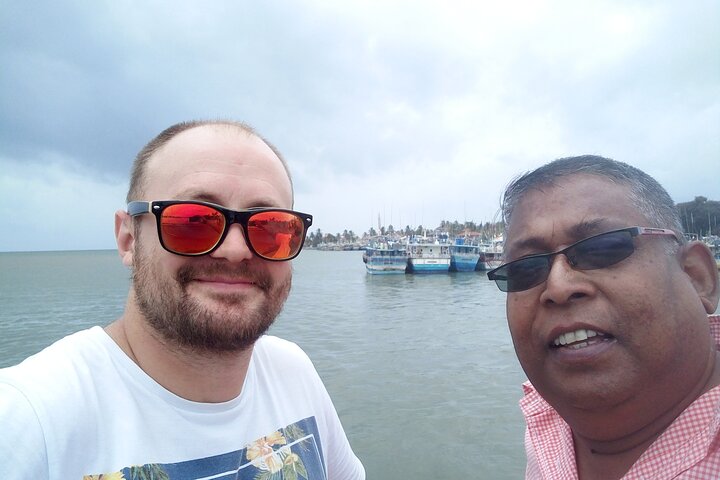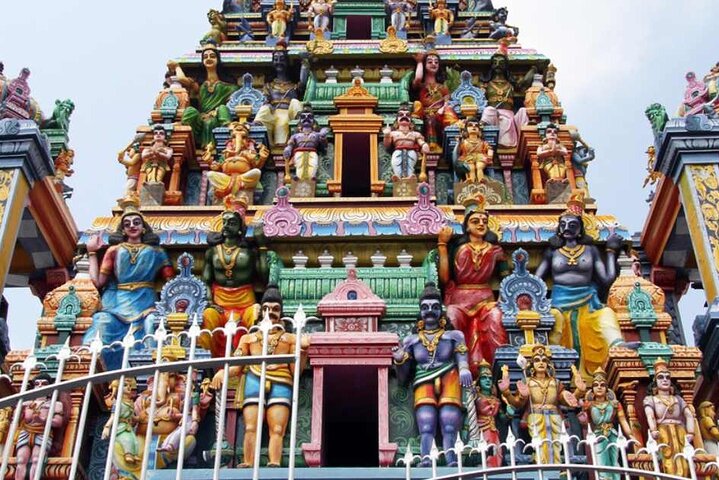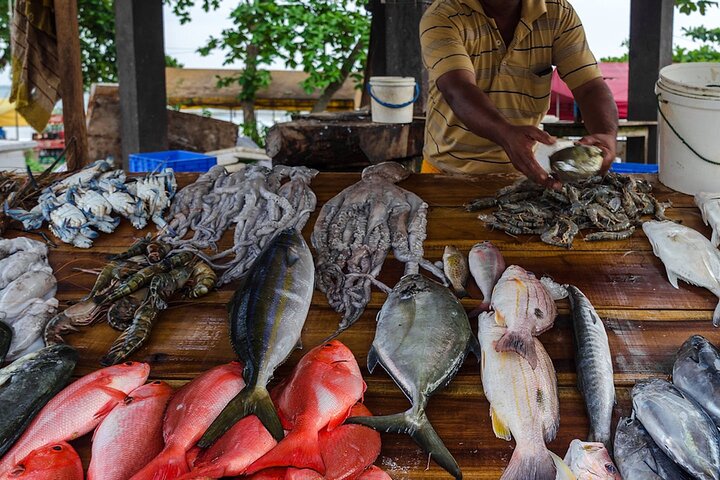Negombo City Tour




















































Negombo is a major city in Sri Lanka, situated on the west coast and at the mouth of the Negombo Lagoon, in the Western Province.
It is one of the major commercial hubs in the country and the administrative centre of Negombo Division. Negombo has about 142,136 population within its divisional secretariat division.
Negombo is known for its long sandy beaches and centuries old fishing industry.It has a large bilingual population of Roman Catholics, known as Negombo Tamils who have their own Tamil dialect but mostly identify themselves as Sinhala.
The best way to explore this beautiful little fishing village is by private transport as there are many places of interest spread out along the beach and the city.
You will be met at your hotel after breakfast and taken round on the city tour by our experienced chauffeur / guides, .
The uniqueness of this tour is meeting it's people who live in harmony in this small and multicultural city.
Description
Itinerary
This is a typical itinerary for this product
Stop At: Negombo Fish Market, Negombo Sri Lanka
The Negombo Fish Market is interesting because it takes place right on the beach, fresh from fishing boats. Crowds of fishermen are seen untangling their fishing nets, playing with their kids, and stretching out miles of fish to dry in the sun on Negombo's shore.
A must see place when you are in Negombo.
Duration: 30 minutes
Stop At: St. Mary's Church, Main Street, Negombo 22100 Sri Lanka
A grand old Catholic church built in the 18th century.
St. Mary’s Church, Negombo is landmark edifice, a Roman Catholic church in the heart of Negombo. Its exterior surface is painted in pink colour. It is one of the largest cathedrals in Sri Lanka.
Negombo has been influenced greatly by the Christian faith from the time it was occupied by the Portuguese. It is often called "Little Rome" in view of the large number of churches in the city.
Construction of the church was started in 1874 and completed, after a long gap, in 1922. The art and architecture of this church and a few similar other churches in Sri Lanka demonstrate the cultural amalgamation of the European practice with Sri Lankan art and architecture during the early years of the 20th century.
The church was built in neoclassicism style with columns and plain walls. Its ceilings are painted with alabaster images of many saints. The walls at the upper level are fixed with sculptures of religious saints. The unique paintings on the life of Christ on the ceiling were done by the N.S. Godamanne, a local Buddhist painter. The beauty of the paintings on the nave is described as "thunderous". A testator paid the cost of one of the altars, which was imported from Europe
Duration: 15 minutes
Stop At: Angurukaramulla Temple, Temple road, Negombo 22100 Sri Lanka
The Angurukaramulla Temple is a good place to visit if you're in Negombo. It's best known for its epic statue of the Buddha, and its dragon-entrance - inside you find detailed murals that date back centuries. There is also a 300+ year old ruin of a historic library here, covered in moss.
Please note : Rs.1000 is charged as entrance fee to the Temple
Duration: 1 hour
Stop At: Sri Singama Kali Amman Kovil, Sea St, Negombo 11500 Sri Lanka
Sri Singama Kali Amman Kovil is a major Hindu religious site. The stunning murals and sculptures of the temple make it a site well worth visiting!
Duration: 15 minutes
Stop At: Dutch Canal, Custom House Road, Negombo 22100 Sri Lanka
The Hamilton Canal (also commonly known as the Dutch Canal) is a 14.5 km (9.0 mi) canal connecting Puttalam to Colombo, passing through Negombo in Sri Lanka. The canal was constructed by the British in 1802 and completed in 1804. It was designed to drain salt water out of the Muthurajawela wetlands. The canal was named after Gavin Hamilton, the Government Agent of Revenue and Commerce.
Duration: 15 minutes
Stop At: Dutch Fort, Esplanade Road, Negombo 22100 Sri Lanka
Negombo Fort was a small but important fort in Negombo, approx. 30 km (19 mi) north of Colombo, that was built by the Portuguese to defend Colombo.
In its time the fort at Negombo was probably the next in strategic importance after Colombo, Jaffna and Galle. The original Portuguese fort was a weak structure, which was captured by Dutch forces commanded by Philip Lucasz, in February 1640.The Portuguese made several attempts to retake it before they were successful in December 1640. They then strengthened the fortifications and managed to defend the fort until it was recaptured by the Dutch, commanded by Francois Caron, in January 1644.The original bastions were destroyed by the Dutch cannons during the siege of the fort. The Dutch subsequently rebuilt it in 1672 however not on the usual square pattern, but on a pentagonal one, though it had only four bulwarks, the fifth was never constructed (possibly due to the cost). The fort was located on a narrow strip of land between a lagoon and an inlet of the sea. It was surrounded by a dry moat, and the gate was accessed via a drawbridge.
In February 1796 it was occupied by the British without opposition. In the late 1800s the British authorities decided to demolish the fort and build a prison in its place, constructed from the stones of the fort.Today all that remains is a section of the eastern rampart with mounds at its northern and Southern ends, where the previous bastions existed, and an recessed arched gateway. Above the gateway is a slab of granite, with the date 1678 inscribed, surmounted by a high decorative gable. The site is still used as a prison by the Department of Prisons.
Duration: 15 minutes
Stop At: Dutch Fort, Esplanade Road, Negombo 22100 Sri Lanka
Saint Stephen's Church, Negombo, is an Anglican church in Negombo. It was consecrated on 31 July 1880 in the presence of dedicated devotees which included several Wesleyans. Service was also conducted in the Sinhalese language on the occasion when a Sinhalese woman was also baptised, under the sponsorship of two English women.
In the 18th century most of the settlements in Ceylon (now Sri Lanka) became a British territory annexed from the Dutch. But it was only in 1815, following the collapse of the Kandyan Kingdom, that the entire island came under British suzerainty. The Diocese of Colombo came into existence in 1845 and James Chapman was the first Bishop of Colombo. The Anglican community wanted to establish a church in Negombo in the nineteenth century and action was initiated by choosing a suitable site for the purpose in 1876. The area in which the site was chosen had previously been known as "The Dutch Fort".The Bishop of Colombo, Reverend Reginald Stephen Copleston, provided a Crown grant under order dated 23 September 1876 to build the church. The trustees of the church from Negombo were Henry Bell, Charles Karlenberg and Harry Maule F. Finch. The site measured two roods and 17 perches (One rood is equal to 10,890 square feet (1,012 m2) and 40 perches are equal to a rood). The church was constructed by the end of 1877, although church services were held before its formal consecration. The formal consecration ceremony was held on 31 July 1879.
Duration: 15 minutes
Inclusions
- Bottled water
- Air-conditioned vehicle
- All Fees and Taxes
Exclusions
- Restroom on board
- WiFi on board
Additional information
- Not wheelchair accessible
- Infants must sit on laps
- Travelers should have a moderate physical fitness level
- Face masks required for travelers in public areas
- Face masks required for guides in public areas
- Social distancing enforced throughout experience
- Transportation vehicles regularly sanitized
- Guides required to regularly wash hands
- Temperature checks for travelers upon arrival
- As the situation of Sri Lanka is different from many other countries please let the guide advise you on the current situation upon arrival.
- This experience requires good weather. If it’s canceled due to poor weather, you’ll be offered a different date or a full refund
- This tour/activity will have a maximum of 2 travelers
- Confirmation will be received at time of booking
Ticket delivery
You can present either a paper or an electronic voucher for this activity.
Operates
See Availability
Cancellation
For a full refund, cancel at least 24 hours in advance of the start time of the experience.
Culture Tours, Sightseeing & Cruises Tours & Sightseeing Private and Luxury Bus Tours City Tours Cultural Tours Historical Tours
Checkout these other experiences on Plan Harmony
- Kazui's Kabuki-za Gallery & shopping tour
- Savannah History and Haunts Candlelit Ghost Walking Tour
- 3 Hour Guided TomCar ATV Tour in Sonoran Desert
- Half-Day Whale Watching Adventure from Victoria
- Ziplining Forest Adventure - The Original Canopy Tour Rotorua
- Adventure Dubrovnik - Sea Kayaking and Snorkeling Tour
- Winter kayaking & fika tour among islands of Stockolm Archipelago
- 3-hour Complete Prague Bike Tour
- Seward and Kenai Fjords National Park Guided Tour with Lunch
- Cu Chi Tunnels in Ben Dinh by Luxury Speed Boat